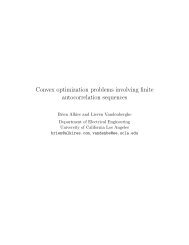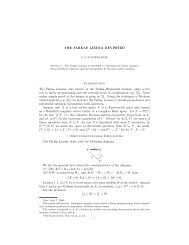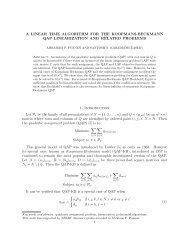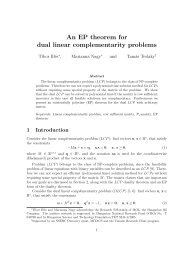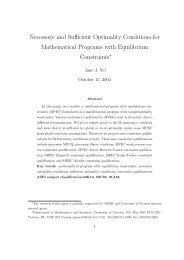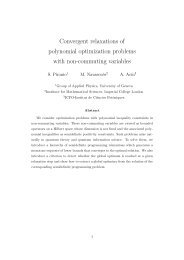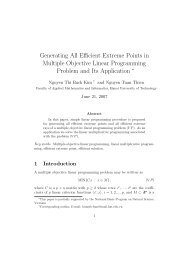steepest edge as applied to the standard simplex method
steepest edge as applied to the standard simplex method
steepest edge as applied to the standard simplex method
You also want an ePaper? Increase the reach of your titles
YUMPU automatically turns print PDFs into web optimized ePapers that Google loves.
Steepest Edge <strong>as</strong> Applied <strong>to</strong> <strong>the</strong> Standard Simplex Method<br />
Gavriel Yarmish, Brooklyn College<br />
City University of New York<br />
(yarmish@sci.brooklyn.cuny.edu)<br />
Abstract<br />
In this paper we discuss results and advantages of using <strong>steepest</strong> <strong>edge</strong> column choice rules and <strong>the</strong>ir derivatives. We<br />
show empirically, when we utilize <strong>the</strong> <strong>steepest</strong> <strong>edge</strong> column choice rule for <strong>the</strong> tableau <strong>method</strong>, that <strong>the</strong> density<br />
crossover point at which <strong>the</strong> tableau <strong>method</strong> is more efficient than <strong>the</strong> revised <strong>method</strong> drops <strong>to</strong> 5%. This is much<br />
lower than <strong>the</strong> 72% we have seen when <strong>the</strong> tableau <strong>method</strong> used <strong>the</strong> cl<strong>as</strong>sical column choice rule. This is because <strong>the</strong><br />
revised <strong>method</strong> loses much of its gain in terms of lower iteration count due <strong>to</strong> <strong>the</strong> extra computation necessary in<br />
applying <strong>steepest</strong> <strong>edge</strong> rules. This can also be seen via a <strong>the</strong>oretical analysis.<br />
1. Introduction<br />
Dantzig's <strong>simplex</strong> algorithm for linear programming h<strong>as</strong> two major variants: <strong>the</strong> original, or<br />
<strong>standard</strong> tableau <strong>method</strong>, and <strong>the</strong> revised <strong>method</strong>. Today, virtually all serious implementations are<br />
b<strong>as</strong>ed on <strong>the</strong> revised <strong>method</strong> because it is much f<strong>as</strong>ter for sparse LPs, which are most common.<br />
However, <strong>the</strong> <strong>standard</strong> <strong>method</strong> h<strong>as</strong> advantages <strong>as</strong> well. First, <strong>the</strong> <strong>standard</strong> <strong>method</strong> is effective for<br />
dense problems. While dense problems are uncommon in general, <strong>the</strong>y occur frequently in some<br />
important applications such <strong>as</strong> wavelet decomposition, digital filter design, text categorization,<br />
image processing and relaxations of scheduling problems [6, 9, 31].<br />
Second, <strong>the</strong> <strong>standard</strong> <strong>method</strong> can be e<strong>as</strong>ily and effectively extended <strong>to</strong> a coarse grained, distributed<br />
algorithm [32]. There have been a number of parallel implementations for <strong>the</strong> revised <strong>method</strong> but<br />
<strong>the</strong>y have had limited success. Bürger et al proposes a distributed peer <strong>to</strong> peer algorithm <strong>to</strong> solve<br />
degenerate linear programs [5], Plosk<strong>as</strong> et al [25] presents a parallel shared memory implementation of<br />
<strong>the</strong> revised <strong>method</strong>. Lalami et al [19, 20] discusses a parallel implementation via using CPU-GPU<br />
processors. There have been many o<strong>the</strong>r attempts. For a review of various parallel implementations of <strong>the</strong><br />
<strong>simplex</strong> algorithm see Hall [17]. Bixby and Martin [4] attempted a distributed version of <strong>the</strong> revised <strong>method</strong><br />
utilizing <strong>the</strong> <strong>steepest</strong> <strong>edge</strong> rule. They report that <strong>the</strong>re is little hope achieving good parallel performance<br />
with a distributed-memory model. They also tried with shared-memory up <strong>to</strong> a maximum of four processors<br />
with mixed results. Work h<strong>as</strong> been done that takes advantage of problems with special structures. Hall and<br />
Hangfu have written revised <strong>simplex</strong> code that takes advantage of hyper-sparsity and more recently Hall h<strong>as</strong><br />
written a distributed version of <strong>the</strong> revised <strong>method</strong> that takes advantage of problems with a block-structure<br />
[15, 16]. At this point <strong>the</strong>re are no truly scalable distributed versions of <strong>the</strong> revised <strong>simplex</strong> <strong>method</strong><br />
for general linear programming problems.<br />
Finally, non<strong>standard</strong> column choice rules, in particular <strong>the</strong> <strong>steepest</strong> <strong>edge</strong> rule, are efficiently<br />
implemented in <strong>the</strong> <strong>standard</strong> tableau <strong>simplex</strong> <strong>method</strong>. There h<strong>as</strong> been much discussion of utilizing<br />
alternate column choice rules for <strong>the</strong> revised <strong>method</strong> [11, 14, 21, 24, 27–29] including ways <strong>to</strong><br />
make it more efficient. We show that when utilizing <strong>the</strong> tableau <strong>method</strong> <strong>the</strong> advantages are much<br />
more pronounced and we discuss results and advantages of using <strong>steepest</strong> <strong>edge</strong> column choice<br />
rules and <strong>the</strong>ir derivatives.
We show empirically, when we utilize <strong>the</strong> <strong>steepest</strong> <strong>edge</strong> column choice rule for <strong>the</strong> tableau<br />
<strong>method</strong>, that <strong>the</strong> density crossover point at which <strong>the</strong> tableau <strong>method</strong> is more efficient than <strong>the</strong><br />
revised <strong>method</strong> drops <strong>to</strong> 5%. This is much lower than <strong>the</strong> 72% we have seen when <strong>the</strong> tableau<br />
<strong>method</strong> used <strong>the</strong> cl<strong>as</strong>sical column choice rule. This is because <strong>the</strong> revised <strong>method</strong> loses much of its<br />
gain in terms of lower iteration count due <strong>to</strong> <strong>the</strong> extra computation necessary in applying <strong>steepest</strong><br />
<strong>edge</strong> rules. This can also be seen via a <strong>the</strong>oretical analysis.<br />
We also provide a <strong>the</strong>oretical analysis of <strong>the</strong> extra computational cost of using <strong>steepest</strong> <strong>edge</strong><br />
<strong>method</strong>s tableau vs. revised and show how it is advantageous <strong>to</strong> <strong>the</strong> tableau <strong>method</strong> but not so<br />
much so for <strong>the</strong> revised <strong>method</strong>.<br />
The <strong>steepest</strong> <strong>edge</strong> rule amongst o<strong>the</strong>r alternate column choice rules h<strong>as</strong> been known in <strong>the</strong>ory <strong>as</strong><br />
far back <strong>as</strong> <strong>the</strong> <strong>simplex</strong> <strong>method</strong> itself. Tests <strong>to</strong> empirically compare <strong>the</strong> number of iterations on a<br />
number of different column choice rules were performed by Kuhn, Quant, Cutler and Wolf in <strong>the</strong><br />
early ‘60s [13, 30]. Both <strong>the</strong> <strong>steepest</strong> <strong>edge</strong> rule and <strong>the</strong> greatest change rule were both empirically<br />
shown <strong>to</strong> require fewer iterations than <strong>the</strong> cl<strong>as</strong>sical Dantzig rule. On <strong>the</strong> o<strong>the</strong>r hand, <strong>the</strong> cost per<br />
iteration is higher when using <strong>the</strong>se rules.<br />
Our empirical study did not include <strong>the</strong> revised <strong>method</strong> running <strong>the</strong> <strong>steepest</strong> <strong>edge</strong> update <strong>method</strong>s<br />
due <strong>to</strong> <strong>the</strong> fact that <strong>the</strong> implementation of <strong>the</strong> revised <strong>method</strong> we had access <strong>to</strong> did not have an<br />
option for <strong>the</strong> <strong>steepest</strong> <strong>edge</strong>. Only some revised implementations include it due <strong>to</strong> <strong>the</strong> difficulties<br />
described in this paper.<br />
Never<strong>the</strong>less, we do include empirical evidence b<strong>as</strong>ed on Eigen [10], that computational gains for<br />
<strong>the</strong> revised <strong>method</strong> of lowering <strong>the</strong> number of iterations is almost wiped out and in some c<strong>as</strong>es is<br />
negative due <strong>to</strong> <strong>the</strong> extra computational per iteration.<br />
In a previous paper [32] we showed that, when using <strong>the</strong> cl<strong>as</strong>sical column choice rule, <strong>the</strong> density<br />
crossover point when using distributed parallel processors for a 1,000 x 5,000 size problem can be<br />
lowered <strong>to</strong> less than 10% density down from ~72% for a single processor.<br />
We thus have <strong>the</strong> following table when comparing single processor revised <strong>method</strong> with <strong>the</strong><br />
cl<strong>as</strong>sical column choice rule <strong>to</strong> <strong>the</strong> tableau <strong>method</strong> when <strong>the</strong> tableau <strong>method</strong> uses<br />
<strong>the</strong> cl<strong>as</strong>sical column choice rule and a single processor,<br />
distributed processors with <strong>the</strong> cl<strong>as</strong>sical column choice rule and when it uses <strong>the</strong><br />
<strong>steepest</strong> <strong>edge</strong> column choice rule with a single processor:<br />
Density crossover point Single processor Optimal distributed processors<br />
Cl<strong>as</strong>sical CCR ~72%
Section 2 is a brief review of <strong>the</strong> <strong>simplex</strong> algorithm, it reviews both tableau and revised <strong>method</strong><br />
and includes a cost comparison between <strong>the</strong>m. Section 3 reviews results and advantages of using a<br />
distributed tableau <strong>method</strong>. Sections 4 and 5 describe a number of alternative column choice rules<br />
and explain <strong>the</strong> re<strong>as</strong>on that <strong>the</strong>y are computationally difficult for <strong>the</strong> revised <strong>method</strong>. Section 6<br />
first reviews <strong>the</strong> <strong>steepest</strong> <strong>edge</strong> update rule for <strong>the</strong> revised <strong>method</strong>. It <strong>the</strong>n shows a per-iteration cost<br />
analysis; cl<strong>as</strong>sic vs. <strong>steepest</strong> <strong>edge</strong> rules for tableau and revised <strong>method</strong>s. Section 8 shows<br />
experimental results b<strong>as</strong>ed on Eigen [10] that compares <strong>the</strong> cl<strong>as</strong>sical and <strong>steepest</strong> <strong>edge</strong> rules, both<br />
<strong>the</strong> exact update rule of Forrest and Goldfarb [11] and <strong>the</strong> Devex approximations of Harris [18].<br />
This comparison is for <strong>the</strong> revised <strong>method</strong> only. Section 9 h<strong>as</strong> <strong>the</strong> results of an experimental study<br />
that shows <strong>the</strong> density crossover point of <strong>the</strong> tableau vs. <strong>the</strong> revised <strong>method</strong>. This crossover point<br />
is given both when <strong>the</strong> tableau <strong>method</strong> uses <strong>the</strong> cl<strong>as</strong>sical column choice rule and when it uses <strong>the</strong><br />
<strong>steepest</strong> <strong>edge</strong> column choice rule. Finally, section 10 is a summary.<br />
2. Review<br />
2.1 The <strong>standard</strong> Simplex Method<br />
In this section we briefly outline <strong>the</strong> <strong>simplex</strong> algorithm and <strong>as</strong>sume that <strong>the</strong> reader h<strong>as</strong> some<br />
familiarity with it.<br />
We consider linear programs in <strong>the</strong> general form:<br />
Max z cx<br />
x<br />
l<br />
u<br />
b Ax b<br />
l x u for j 1,..., n<br />
j j j<br />
(1)<br />
Or with y Ax we have:<br />
Maximize z <br />
x<br />
n<br />
<br />
j1<br />
n<br />
c x<br />
Subject <strong>to</strong> y a x ( i 1, 2,..., m)<br />
(2)<br />
i ij j<br />
j1<br />
j<br />
j<br />
l<br />
u<br />
l x u for j 1,..., n; b y b for i 1,..., m<br />
j j j i i i<br />
A = {a ij } is a given m x n matrix, x is an n-vec<strong>to</strong>r of decision variables x j , each with given lower<br />
bound l j and upper bound u j . The m-vec<strong>to</strong>rs b l and b u are given data that define constraints. The<br />
lower bound, l j , may take on <strong>the</strong> value - and <strong>the</strong> upper bound, u j , may take on <strong>the</strong> value +.<br />
Similarly, some or all of <strong>the</strong> components of b l may be -, and some or all of b u may be +.<br />
Equation (2) <strong>to</strong>ge<strong>the</strong>r with an <strong>as</strong>signment of values <strong>to</strong> <strong>the</strong> non-b<strong>as</strong>ic variables x is a variant of <strong>the</strong><br />
dictionary representation of Strum and Chvátal [7].<br />
Page 3 of 17
2.2 The Revised Simplex Method<br />
In <strong>the</strong> <strong>standard</strong> <strong>simplex</strong> <strong>method</strong>, most of <strong>the</strong> effort in moving from one dictionary, (2), <strong>to</strong> <strong>the</strong> next<br />
comes from calculating <strong>the</strong> new a ij and c j coefficients. In general, most of <strong>the</strong>se coefficients change<br />
for each new dictionary. This is particularly onerous if <strong>the</strong> number of columns, n, is relatively large<br />
compared <strong>to</strong> <strong>the</strong> number of rows, m. Moreover, sparsity is lost. That is, if most of <strong>the</strong> data elements<br />
are zero in <strong>the</strong> original dictionary, <strong>the</strong>y fill in very quickly with non-zero values in a few iterations<br />
of <strong>the</strong> <strong>standard</strong> <strong>method</strong>. Particularly frustrating is that only a small part of each dictionary is used<br />
or even looked at!<br />
To perform an iteration of <strong>the</strong> <strong>simplex</strong> <strong>method</strong>, we require only <strong>the</strong> following from <strong>the</strong> dictionary<br />
(2) (<strong>as</strong>suming we are using <strong>the</strong> cl<strong>as</strong>sical column choice rule):<br />
1) The objective coefficients c j j=1,...,n,<br />
2) The constraint coefficients, a is i = 1,...,m, for <strong>the</strong> pivot column, s, and<br />
3) The current values of <strong>the</strong> b<strong>as</strong>ic variables, y i .<br />
Item 1) is used <strong>to</strong> determine <strong>the</strong> pivot column, and Items 2) and 3) are used <strong>to</strong> determine <strong>the</strong> pivot<br />
row. In summary, we only use two columns and one row from all <strong>the</strong> data in <strong>the</strong> dictionary.<br />
By <strong>the</strong> early 1950's, George Dantzig and William Orchard-Hays [8] realized that <strong>the</strong>se three<br />
elements could be derived from one, fixed, original dictionary <strong>to</strong>ge<strong>the</strong>r with a changing, auxiliary<br />
data structure that requires less work <strong>to</strong> update than <strong>the</strong> work required <strong>to</strong> change dictionaries. For<br />
most linear programs found in practice, it is more efficient <strong>to</strong> represent <strong>the</strong> current dictionary<br />
implicitly in terms of <strong>the</strong> original system and <strong>the</strong> auxiliary data structure ra<strong>the</strong>r than explicitly<br />
updating <strong>the</strong> form (2). Such an approach is called a revised <strong>simplex</strong> <strong>method</strong> and is more efficient<br />
for linear programs that are sparse (low density) and have high <strong>as</strong>pect ratio (n/m).<br />
To explain more about this, it is convenient <strong>to</strong> rec<strong>as</strong>t (2). We rename y i <strong>as</strong> -x n+i for i = 1,...,m and<br />
reconfigure (2) in matrix form <strong>as</strong>:<br />
Maximize z CX<br />
x<br />
Subject <strong>to</strong> : AX 0<br />
L X U<br />
where X = [x 1 , x 2 , ..., x n , x n+1 , ..., x n+m ], C = [c 1 , c 2 , ..., c n , 0, ...,<br />
0], N = {a ij }, A = [N | I], L=[l 1 ,…,l n , -b l 1 , …,-b l a1s<br />
<br />
m ], and<br />
1 0 0<br />
U=[u 1 ,…,u n , -u l 1 ,…,-b l a<br />
<br />
<br />
rs<br />
<br />
m ].<br />
a2s<br />
<br />
0 1 0<br />
In this notation, each different direc<strong>to</strong>ry (2) corresponds <strong>to</strong> a<br />
a<br />
<br />
<br />
rs <br />
different b<strong>as</strong>is, B, of A. By adding appropriate multiples of <strong>the</strong><br />
<br />
<br />
<br />
<br />
constraints AX=0, <strong>to</strong> <strong>the</strong> objective we also maintain zero<br />
P <br />
<br />
<br />
1 <br />
coefficients for <strong>the</strong> b<strong>as</strong>ic variables in <strong>the</strong> successive C vec<strong>to</strong>rs.<br />
<br />
<br />
<br />
ars<br />
<br />
These operations can be expressed directly in matrix terms. For<br />
<br />
<br />
example, if we are going <strong>to</strong> pivot in column s (making <strong>the</strong> nonb<strong>as</strong>ic<br />
variable x s b<strong>as</strong>ic) and replace <strong>the</strong> b<strong>as</strong>ic variable<br />
a<br />
<br />
<br />
<br />
<br />
<br />
ms<br />
<br />
0 0 1<br />
corresponding <strong>to</strong> row r, we premultiply A by P where:<br />
a <br />
<br />
rs <br />
Modulo some renumbering of equations and variables, <strong>the</strong><br />
matrix A is updated iteration by iteration by premultiplying by P matrices. So after some number<br />
of iterations, k, <strong>the</strong> new constraint matrix A' can be given in terms of <strong>the</strong> original one, A, by A' =[<br />
P k P k-1 P 1 ]A. Again within numbering of rows and columns B -1 = P k P k-1 P 1 is <strong>the</strong> inverse of<br />
<strong>the</strong> current b<strong>as</strong>is, B.<br />
(3)<br />
Page 4 of 17
B -1 suffices <strong>to</strong> obtain from <strong>the</strong> original matrix A all we need at an arbitrary iteration, k. So this is<br />
our first example of an auxiliary structure. This is called <strong>the</strong> revised <strong>simplex</strong> <strong>method</strong> using <strong>the</strong><br />
explicit inverse.<br />
Clearly, we can represent <strong>the</strong> b<strong>as</strong>is inverse <strong>as</strong> a product of <strong>the</strong> individual P matrices (actually you<br />
need only save <strong>the</strong> column with non-trivial entries and its index) separately <strong>as</strong> ano<strong>the</strong>r auxiliary<br />
structure. This is called <strong>the</strong> product form of <strong>the</strong> inverse.<br />
More common <strong>to</strong>day is <strong>the</strong> LU decomposition of B (see, for example, [23], Sections 7.6.1 and<br />
A.5]); The LU decomposition offers better numerical stability. Heuristics are used for (i)<br />
accomplishing <strong>the</strong> initial LU decomposition for (ii) <strong>the</strong> updating of <strong>the</strong> decomposition, and (iii)<br />
determining <strong>the</strong> frequency of updating. They seek an optimal tradeoff between numerical stability<br />
and <strong>the</strong> maintenance of sparsity corresponding <strong>to</strong> that of <strong>the</strong> original matrix B. [1, 26]. In this<br />
context Step 3, "pivot," corresponds <strong>to</strong> <strong>the</strong> updating of <strong>the</strong> LU decomposition, and its periodic<br />
(usually at most every 100 iterations) reinitialization or refac<strong>to</strong>rization.<br />
2.3 Cost comparison of <strong>the</strong> tableau and revised <strong>method</strong>s for cl<strong>as</strong>sical column choice rule<br />
With ideal computation, <strong>the</strong> revised and <strong>standard</strong> <strong>simplex</strong> <strong>method</strong>s perform <strong>the</strong> same sequence of<br />
column, and row choices and take <strong>the</strong> same number of iterations. This allows us <strong>to</strong> compare<br />
performance of <strong>the</strong> two approaches by comparing <strong>the</strong> average time per iteration ra<strong>the</strong>r than <strong>the</strong><br />
<strong>to</strong>tal running time. This is very convenient because performance models of <strong>the</strong> time per iteration<br />
are much e<strong>as</strong>ier <strong>to</strong> come by than for <strong>to</strong>tal time. In o<strong>the</strong>r c<strong>as</strong>es, for example, in comparing<br />
performance for different column choice rules, <strong>to</strong>tal time must be compared since <strong>the</strong> number of<br />
iterations may be quite different.<br />
As will be discussed below, <strong>the</strong>re are alternative ways <strong>to</strong> choose a column but <strong>the</strong> cl<strong>as</strong>sical rule is<br />
most commonly employed and h<strong>as</strong> <strong>the</strong> lowest computational cost.<br />
The <strong>simplex</strong> <strong>method</strong> consists of three b<strong>as</strong>ic steps:<br />
High-level serial algorithm<br />
a. Column choice<br />
b. Row choice<br />
c. Pivot<br />
Updating any of <strong>the</strong> representations is, at most, of order m 2 average work. On <strong>the</strong> o<strong>the</strong>r hand,<br />
pivoting in <strong>the</strong> <strong>standard</strong> <strong>method</strong> on <strong>the</strong> explicit representation of <strong>the</strong> dictionary takes order mn<br />
work. Thus for high <strong>as</strong>pect ratios, <strong>the</strong> <strong>standard</strong> <strong>method</strong> takes more work.<br />
The following are <strong>the</strong> costs of <strong>the</strong> steps:<br />
Cost of cl<strong>as</strong>sical column choice for tableau <strong>method</strong>: nothing - ̂ is kept explicitly for all j. (The<br />
ratio test cost is being ignored.)<br />
Cost of cl<strong>as</strong>sical column choice for revised <strong>method</strong>:<br />
There are m rows and n-m<br />
nonb<strong>as</strong>ic columns. We <strong>as</strong>sume partial pricing of an average 10% of <strong>the</strong> columns. Of course <strong>the</strong><br />
actual percentage depends on <strong>the</strong> settings of <strong>the</strong> revised <strong>method</strong>.<br />
Page 5 of 17
Cost of row choice for tableau <strong>method</strong>: nothing – column ̂ is kept explicitly for all j. (The<br />
comparison for minimum is being ignored.)<br />
Cost of row choice for revised <strong>method</strong>: <strong>to</strong> generate <strong>the</strong> entering column ̂ .<br />
Cost of pivot for tableau <strong>method</strong>: m(n-m)<br />
Cost of pivot for revised <strong>method</strong>: update of <strong>the</strong> B -1 matrix: m 2 - this holds on average with LU<br />
decomposition <strong>to</strong>o<br />
To summarize:<br />
Cost Cl<strong>as</strong>sical column choice Row choice<br />
Pivot<br />
rule<br />
Tableau - - -m)<br />
Revised m 2<br />
Table 2: Cost Comparison of Revised and Tableau for cl<strong>as</strong>sical column choice rule and pivot<br />
3. Use of parallel computing is advantageous <strong>to</strong> <strong>the</strong> tableau <strong>method</strong><br />
As reported in Yarmish and Van Slyke [32], <strong>the</strong> tableau <strong>method</strong> keeps all columns explicitly<br />
whe<strong>the</strong>r <strong>the</strong> column correspond <strong>to</strong> <strong>the</strong> variables currently in in <strong>the</strong> b<strong>as</strong>is or not. It is e<strong>as</strong>y <strong>to</strong><br />
distribute <strong>the</strong> column amongst many machines.<br />
We described a relatively straightforward parallelization scheme within <strong>the</strong> <strong>standard</strong> <strong>simplex</strong><br />
<strong>method</strong> involves dividing up <strong>the</strong> columns amongst many processors. Instead of <strong>the</strong> three b<strong>as</strong>ic<br />
steps of <strong>the</strong> l<strong>as</strong>t section we would have five b<strong>as</strong>ic steps:<br />
High-level parallel algorithm<br />
a. Column choice – each processor will “price out” its columns and choose a locally best<br />
column (Computation).<br />
b. Communication amongst <strong>the</strong> processors of <strong>the</strong> local best columns. All that is sent is <strong>the</strong><br />
pricing value (a number) of <strong>the</strong> processor’s best column. At <strong>the</strong> end of this step each<br />
processor will know which processor is <strong>the</strong> “winner” and h<strong>as</strong> <strong>the</strong> global column choice<br />
(Communication).<br />
c. Row choice by <strong>the</strong> winning column (Computation).<br />
d. A broadc<strong>as</strong>t of <strong>the</strong> winning processor’s winning column and choice of row<br />
(Communication).<br />
e. A simultaneous pivot by all processors on <strong>the</strong>ir columns (Computation).<br />
For more details and analysis of <strong>the</strong>se steps see Yarmish and Van Slyke [32].<br />
Page 6 of 17
4. Alternative Column Choice Rules for <strong>the</strong> <strong>standard</strong> <strong>simplex</strong> <strong>method</strong><br />
4.1 Three possible column choice rules<br />
Any eligible non-b<strong>as</strong>ic variable may be chosen in <strong>the</strong> column choice step of <strong>the</strong> <strong>simplex</strong> <strong>method</strong>.<br />
We discuss three approaches <strong>to</strong> picking <strong>the</strong> particular non-b<strong>as</strong>ic variable.<br />
4.1.1 The cl<strong>as</strong>sical column choice rule<br />
The original rule used by Dantzig w<strong>as</strong> <strong>to</strong> choose <strong>the</strong> eligible c' j in <strong>the</strong> current dictionary with <strong>the</strong><br />
largest absolute value. This selects <strong>the</strong> non-b<strong>as</strong>ic variable that gives <strong>the</strong> largest improvement in <strong>the</strong><br />
objective function per unit change of <strong>the</strong> non-b<strong>as</strong>ic variable. This criterion is very simple and<br />
straightforward <strong>to</strong> compute. In contr<strong>as</strong>t <strong>to</strong> some of o<strong>the</strong>r <strong>method</strong>s, <strong>the</strong> column is chosen without<br />
looking at any of <strong>the</strong> coefficients, a' ij . However, it is h<strong>as</strong> <strong>the</strong> undesirable feature that by rescaling<br />
<strong>the</strong> variables you can cause any eligible column <strong>to</strong> be chosen.<br />
4.1.2 The greatest change rule<br />
For each eligible column, perform <strong>the</strong> row choice step of <strong>the</strong> <strong>simplex</strong> <strong>method</strong> and <strong>the</strong>n compute<br />
<strong>the</strong> improvement in <strong>the</strong> objective that would result if <strong>the</strong> column were chosen, and use this <strong>as</strong> <strong>the</strong><br />
column choice rule. This is called <strong>the</strong> greatest change criterion. It takes even more work than <strong>the</strong><br />
<strong>steepest</strong> <strong>edge</strong> rule. The payoff seems no better than for <strong>the</strong> <strong>steepest</strong> <strong>edge</strong> rule, so it is rarely used<br />
(see Section 9.2). Never<strong>the</strong>less, this <strong>method</strong> can be implemented e<strong>as</strong>ily in <strong>standard</strong><br />
implementations.<br />
4.1.3 The <strong>steepest</strong> <strong>edge</strong> column choice rule<br />
The dependence of <strong>the</strong> column choice on scaling of <strong>the</strong> cl<strong>as</strong>sical <strong>method</strong> can be removed by<br />
normalizing <strong>the</strong> value of c' j by <strong>the</strong> length of <strong>the</strong> column in <strong>the</strong> current dictionary corresponding <strong>to</strong><br />
<strong>the</strong> non-b<strong>as</strong>ic variable j. Applying <strong>the</strong> <strong>steepest</strong> <strong>edge</strong> rule requires more work per iteration for both<br />
<strong>standard</strong> and revised <strong>method</strong>s. In both c<strong>as</strong>es, for each eligible column one h<strong>as</strong> <strong>to</strong> compute <strong>the</strong> norm<br />
of <strong>the</strong> column in terms of <strong>the</strong> current b<strong>as</strong>is. In addition, in revised <strong>method</strong>s, one does not have<br />
readily at hand <strong>the</strong> current representation a' ij . This would seem <strong>to</strong> rule out <strong>the</strong> <strong>steepest</strong> <strong>edge</strong> rule for<br />
revised implementations; however, clever recursive computations can be used <strong>to</strong> implement <strong>the</strong><br />
rule with modest cost [11]. The Devex rule of Harris [18] is ano<strong>the</strong>r scheme for <strong>the</strong> revised <strong>method</strong><br />
that approximates <strong>the</strong> <strong>steepest</strong> <strong>edge</strong> criterion efficiently. In any c<strong>as</strong>e, <strong>the</strong> <strong>standard</strong> <strong>method</strong> h<strong>as</strong> <strong>the</strong><br />
needed coefficients readily available.<br />
5. Computational difficulty of using <strong>steepest</strong> <strong>edge</strong> column choice rules especially for <strong>the</strong><br />
revised <strong>method</strong><br />
5.1 The revised <strong>simplex</strong> does not explicitly keep all information necessary for <strong>the</strong>se rules<br />
As <strong>the</strong> revised <strong>simplex</strong> <strong>method</strong> became <strong>the</strong> de fac<strong>to</strong> <strong>method</strong> <strong>the</strong> cost per iteration of <strong>the</strong>se rules<br />
became even less attractive. This is due <strong>to</strong> <strong>the</strong> fact that <strong>the</strong> nonb<strong>as</strong>ic columns, which are not<br />
explicit in <strong>the</strong> revised <strong>method</strong>, need recalculation for each column.<br />
Page 7 of 17
5.2 Partial pricing<br />
Ano<strong>the</strong>r downside of using <strong>the</strong> <strong>steepest</strong> <strong>edge</strong> <strong>method</strong> is <strong>the</strong> common technique of partial pricing<br />
used in <strong>the</strong> revised <strong>method</strong>. The idea behind partial pricing is <strong>to</strong> avoid <strong>the</strong> costly pricing out of so<br />
many columns. In order <strong>to</strong> take advantage of <strong>the</strong> <strong>steepest</strong> <strong>edge</strong> <strong>method</strong> full pricing needs <strong>to</strong> be<br />
employed. As explained in more detail below employing partial pricing would negate <strong>the</strong> iterationlowering<br />
effects of <strong>the</strong> <strong>steepest</strong> <strong>edge</strong> <strong>method</strong>. This directly impacts <strong>the</strong> extra cost per iteration of<br />
using <strong>the</strong> <strong>steepest</strong> <strong>edge</strong> rule vs. <strong>the</strong> cl<strong>as</strong>sical rule <strong>as</strong> explained below. In <strong>the</strong> context of <strong>the</strong> revised<br />
<strong>method</strong> <strong>the</strong> cost per iteration necessary for <strong>the</strong>se alternate column choice rules, including <strong>the</strong><br />
<strong>steepest</strong> <strong>edge</strong> rule, w<strong>as</strong> <strong>the</strong>refore prohibitive and negated <strong>the</strong> reduction of <strong>the</strong> iteration count.<br />
5.3 Update <strong>method</strong>s for <strong>the</strong> revised <strong>steepest</strong> <strong>edge</strong> are helpful but still costly<br />
More recently efficient update formul<strong>as</strong> for <strong>the</strong> <strong>steepest</strong> <strong>edge</strong> rule, within <strong>the</strong> revised <strong>simplex</strong><br />
<strong>method</strong>, have been developed. The first one, Devex, approximates <strong>the</strong> norms necessary for <strong>the</strong><br />
<strong>steepest</strong> <strong>edge</strong> <strong>method</strong>. Subsequently exact update formul<strong>as</strong> for both <strong>the</strong> primal revised <strong>method</strong> [12]<br />
and for <strong>the</strong> dual revised <strong>method</strong> [11] have been introduced. Although <strong>the</strong> computational cost h<strong>as</strong><br />
been mitigated somewhat by Forrest and Goldfarb’s updating <strong>method</strong> for <strong>the</strong> <strong>steepest</strong> <strong>edge</strong> rule,<br />
<strong>the</strong>re is still significant extra computation necessary in order <strong>to</strong> use <strong>the</strong> <strong>steepest</strong> <strong>edge</strong> rule.<br />
6. Analysis of additional cost per iteration for use of <strong>the</strong> <strong>steepest</strong> <strong>edge</strong> rule revised vs. full<br />
tableau <strong>method</strong><br />
6.1 Steepest <strong>edge</strong> update formula for <strong>the</strong> revised <strong>method</strong><br />
In this section we go through an analysis of <strong>the</strong> <strong>steepest</strong> <strong>edge</strong> update <strong>method</strong> of Forrest and<br />
Goldfarb [11] and <strong>as</strong>sume some familiarity with <strong>the</strong> revised <strong>method</strong> in matrix notation. The key<br />
element <strong>to</strong> keep in mind is that <strong>the</strong> full tableau is not kept explicitly. All columns that correspond<br />
<strong>to</strong> variables not currently in <strong>the</strong> b<strong>as</strong>is must be recomputed from B -1 and from <strong>the</strong> initial column.<br />
The following notation roughly follows N<strong>as</strong>h and Sofer [23].<br />
B is defined <strong>as</strong> <strong>the</strong> square matrix consisting of <strong>the</strong> initial column of <strong>the</strong> current b<strong>as</strong>ic variables.<br />
A j is <strong>the</strong> initial column of <strong>the</strong> j th nonb<strong>as</strong>ic variable<br />
̂ is <strong>the</strong> current column of <strong>the</strong> j th variable. This column is not kept explicitly in <strong>the</strong> revised <strong>method</strong>.<br />
Every variable with a ‘hat’ is value of <strong>the</strong> current matrix which is not kept explicitly in <strong>the</strong><br />
revised <strong>method</strong> but is kept explicitly in <strong>the</strong> tableau <strong>method</strong>.<br />
Steepest <strong>edge</strong> column choice rule:<br />
̂<br />
̂<br />
The norm<br />
|| ̂ || √ ̂ ̂ ̂<br />
Define <strong>the</strong> scalar<br />
̂ ̂ ̂<br />
Page 8 of 17
The <strong>steepest</strong> <strong>edge</strong> update formula for a new<br />
is:<br />
̂ ̂<br />
̂<br />
Where refer <strong>to</strong> <strong>the</strong> updated and previous pivot respectively (<strong>the</strong> ‘hat’ is left off). S within<br />
refers <strong>to</strong> <strong>the</strong> leaving variable and t refers <strong>to</strong> <strong>the</strong> entering variable.<br />
6.2 Cost analysis per iteration cl<strong>as</strong>sical vs. <strong>steepest</strong> <strong>edge</strong> column choice rule for tableau and<br />
revised <strong>method</strong>s<br />
Cost of cl<strong>as</strong>sical column choice for tableau <strong>method</strong>: nothing - ̂ is kept explicitly for all j. (The<br />
comparison for minimum is being ignored.)<br />
Cost of cl<strong>as</strong>sical column choice for revised <strong>method</strong>:<br />
average 10% of <strong>the</strong> columns.<br />
<strong>as</strong>suming partial pricing of an<br />
Cost of <strong>steepest</strong> <strong>edge</strong> <strong>method</strong> for tableau <strong>method</strong>: (<br />
Cost of <strong>steepest</strong> <strong>edge</strong> <strong>method</strong> for revised <strong>method</strong>:<br />
m 2 +m <strong>to</strong> calculate ,<br />
m <strong>to</strong> calculate ̂ ,<br />
m 2 <strong>to</strong> do <strong>the</strong> division and<br />
m 2 +m <strong>to</strong> calculate ̂<br />
for a <strong>to</strong>tal of<br />
(2(m 2 +m)+m 2 +m+sqrt)n =<br />
To summarize:<br />
Cost Cl<strong>as</strong>sical rule Steepest <strong>edge</strong> rule<br />
Tableau -<br />
Revised<br />
Table 3: Cost Comparison of Revised and Tableau for cl<strong>as</strong>sical and <strong>steepest</strong> <strong>edge</strong> column choice rule<br />
It is important <strong>to</strong> note that partial pricing is used <strong>to</strong> great effect in <strong>the</strong> revised <strong>method</strong> when using<br />
<strong>the</strong> cl<strong>as</strong>sical rule but cannot be used with <strong>the</strong> <strong>steepest</strong> <strong>edge</strong> without severely mitigation <strong>the</strong><br />
advantage of <strong>the</strong> <strong>steepest</strong> <strong>edge</strong> <strong>method</strong>. This is because, <strong>as</strong> briefly mentioned earlier, <strong>the</strong> whole<br />
idea of <strong>the</strong> <strong>steepest</strong> <strong>edge</strong> <strong>method</strong> is <strong>to</strong> pick a good choice for an entering variable in order <strong>to</strong> reduce<br />
<strong>the</strong> iteration count. If partial pricing is used this advantage would be negatively affected. The<br />
re<strong>as</strong>on partial pricing is re<strong>as</strong>onable when using <strong>the</strong> cl<strong>as</strong>sical column choice rule, on <strong>the</strong> o<strong>the</strong>r hand,<br />
is precisely that it is not <strong>as</strong> good a heuristic choice and <strong>the</strong>refore it is not <strong>as</strong> negatively affected by<br />
partial pricing.<br />
Page 9 of 17
In summary, when one switches <strong>to</strong> <strong>the</strong> <strong>steepest</strong> <strong>edge</strong> <strong>method</strong> <strong>the</strong> extra cost <strong>to</strong> <strong>the</strong> revised over <strong>the</strong><br />
tableau <strong>method</strong> per iteration is:<br />
It must be pointed out that <strong>the</strong> revised <strong>method</strong> can take advantage of sparsity for this extra<br />
calculation.<br />
7. Experimental comparison of column choice rules for <strong>the</strong> revised <strong>method</strong><br />
Eigen [10] did a comparison of column choice rules including <strong>the</strong> cl<strong>as</strong>sical rule, <strong>the</strong> exact <strong>steepest</strong><br />
<strong>edge</strong> rule and two forms of Devex, which are <strong>steepest</strong> <strong>edge</strong> approximations. The comparisons were<br />
done for <strong>the</strong> Netlib problems. He utilized <strong>the</strong> lpsolve code of Berkelaar [3] plus his own<br />
implementation of a second devex <strong>method</strong>.<br />
He found that <strong>the</strong> cl<strong>as</strong>sical rule does fairly well and fared only slightly worse than devex. Analysis<br />
of his data shows that <strong>the</strong>re is a significant gain in terms of iterations which is not reflected in <strong>the</strong><br />
time savings but is much more modest.<br />
3.5<br />
Seconds<br />
3<br />
2.5<br />
2<br />
1.5<br />
Seconds<br />
1<br />
0.5<br />
0<br />
Dantzig Devex1 Devex2<br />
Figure 1<br />
Page 10 of 17
14000<br />
Iterations<br />
12000<br />
10000<br />
8000<br />
6000<br />
Iterations<br />
4000<br />
2000<br />
0<br />
Dantzig Devex1 Devex2<br />
Figure 2<br />
We used <strong>the</strong> iteration and timing data of <strong>the</strong> netlib problems <strong>as</strong> reported in Eigen [10] <strong>to</strong> generate<br />
figure 1 and figure 2. We did not include in <strong>the</strong> data for <strong>the</strong>se figures problems that did not have<br />
data for <strong>the</strong> Dantzig (cl<strong>as</strong>sical), devex1, devex2 or <strong>the</strong> <strong>steepest</strong> <strong>edge</strong> column choice rules. Figure 1<br />
and figure 2 show <strong>the</strong> average run time and <strong>the</strong> average number of iterations respectively. As can<br />
be seen by inspection although <strong>the</strong> number of iterations used by devex went down <strong>to</strong> only 16% of<br />
<strong>the</strong> number of iterations vis a vis <strong>the</strong> cl<strong>as</strong>sical rule, <strong>the</strong> actual timing w<strong>as</strong> only reduced <strong>to</strong> 63% of<br />
<strong>the</strong> cl<strong>as</strong>sical rule. The exact <strong>steepest</strong> <strong>edge</strong> <strong>method</strong>, although not included in <strong>the</strong>se figures, does<br />
even worse than devex in terms of both iteration count and computation time.<br />
It is worth keeping in mind that <strong>the</strong> Netlib problems are not average problems but were uploaded<br />
<strong>to</strong> <strong>the</strong> reposi<strong>to</strong>ry specifically due <strong>to</strong> <strong>the</strong>ir difficult nature and one h<strong>as</strong> <strong>to</strong> be careful when<br />
extrapolating <strong>to</strong> o<strong>the</strong>r problems.<br />
At le<strong>as</strong>t for this data set, <strong>the</strong> Devex approximation code did better than <strong>the</strong> exact <strong>steepest</strong> <strong>edge</strong><br />
update <strong>method</strong>.<br />
What is important, for us, is <strong>to</strong> note that, for <strong>the</strong> revised <strong>method</strong>, <strong>the</strong> extra computational cost per<br />
iteration significantly reduces computational gains from <strong>the</strong> reduction of <strong>the</strong> iteration count.<br />
8. Experimental Configuration<br />
We performed experiments on problems from <strong>the</strong> Netlib library, and syn<strong>the</strong>tic problems. Both<br />
pose difficulties. The Netlib problems are not at all typical. Many of <strong>the</strong>m have been submitted<br />
because of "n<strong>as</strong>ty" features that make <strong>the</strong>m thorough tests of linear programming codes. See, for<br />
example, Ben-Tal and Nemirovski [2] for a discussion of this. Moreover, <strong>the</strong> problems are very<br />
sparse. Finally, we wished <strong>to</strong> determine <strong>the</strong> performance of retroLP <strong>as</strong> a function of problem<br />
parameters, particularly density. To be able <strong>to</strong> control for <strong>the</strong> problem parameters, syn<strong>the</strong>tic<br />
problems are convenient, but <strong>the</strong>y may have covert features that make <strong>the</strong>m much e<strong>as</strong>ier (or much<br />
Page 11 of 17
harder) than "typical" problems. We used multiple genera<strong>to</strong>rs <strong>to</strong> try <strong>to</strong> minimize this potential<br />
problem.<br />
It is important <strong>to</strong> note that for <strong>the</strong> sake of comparison partial pricing, scaling, and b<strong>as</strong>is "cr<strong>as</strong>hing,"<br />
were disabled for <strong>the</strong>se tests.<br />
8.1 Test Sets<br />
Netlib contains problems for testing linear programming codes [www.netlib.org/lp/data, 1996].<br />
While our program successfully ran all <strong>the</strong> Netlib problems, we used <strong>as</strong> our test set <strong>the</strong> 30 densest<br />
problems. These include all problems with density above 2.5%<br />
We used three syn<strong>the</strong>tic program genera<strong>to</strong>rs. Each takes <strong>as</strong> input, m = number of rows, n = number<br />
of columns, d = <strong>the</strong> density of <strong>the</strong> non-zero coefficients (0 < d 1), and seed = <strong>the</strong> seed for <strong>the</strong><br />
random number genera<strong>to</strong>r. All <strong>the</strong> constraints are of <strong>the</strong> less than or equal type. Whe<strong>the</strong>r a<br />
coefficient, a ij , of <strong>the</strong> constraint matrix is non-zero (or zero) is determined randomly with<br />
probability d. For one of <strong>the</strong> genera<strong>to</strong>rs, <strong>the</strong> value of a non-zero coefficient is chosen at random,<br />
uniformly between -1 and 1. The objective coefficients are generated randomly between -1 and 1<br />
(<strong>the</strong> sparsity condition does not apply <strong>to</strong> <strong>the</strong> objective). The variables are constrained <strong>to</strong> be<br />
between -m and m. The constraints are constrained <strong>to</strong> range between -1 and 1. Since, setting all<br />
variables <strong>to</strong> 0 is fe<strong>as</strong>ible, no Ph<strong>as</strong>e 1 is required. The o<strong>the</strong>r two genera<strong>to</strong>rs are similar.<br />
8.2 MINOS<br />
We use MINOS 5.5 [22] <strong>as</strong> a representative implementation of <strong>the</strong> revised <strong>simplex</strong> <strong>method</strong>. We<br />
installed it <strong>to</strong> run in <strong>the</strong> same environment <strong>as</strong> retroLP. This allowed us <strong>to</strong> make re<strong>as</strong>onable<br />
comparisons between <strong>the</strong> <strong>standard</strong> and revised <strong>simplex</strong> <strong>method</strong>s. The purpose of <strong>the</strong>se<br />
comparisons is not so much <strong>to</strong> compare running times but <strong>to</strong> examine <strong>the</strong> relative behavior of <strong>the</strong>se<br />
approaches <strong>as</strong> <strong>the</strong> parameters of interest, primarily density, are varied. In general we used <strong>the</strong><br />
default parameters with MINOS with a few, significant exceptions designed <strong>to</strong> make MINOS more<br />
comparable with retroLP. For <strong>the</strong> sake of comparison partial pricing, scaling, and b<strong>as</strong>is "cr<strong>as</strong>hing,"<br />
were disabled for <strong>the</strong>se tests.<br />
9. Experimental Results: Density crossover points of tableau vs. revised <strong>method</strong>s for cl<strong>as</strong>sical<br />
and <strong>steepest</strong> <strong>edge</strong> column choice rules<br />
9.1 Eligible Columns<br />
When using <strong>steepest</strong> <strong>edge</strong>, or greatest change column choice rules, <strong>the</strong> amount of work in "pricing<br />
out" a column differs dramatically depending on whe<strong>the</strong>r <strong>the</strong> column is eligible or not. To<br />
determine eligibility, b<strong>as</strong>ically two comparisons are needed; however, if <strong>the</strong> column is, in fact,<br />
eligible an additional order m computations are needed. So for accurate performance analysis it is<br />
useful <strong>to</strong> be able <strong>to</strong> estimate <strong>the</strong> fraction of columns that are eligible. When using greatest change<br />
column choice rule on <strong>the</strong> 30 Netlib problems, <strong>the</strong> fraction of columns that are eligible ranges from<br />
4.6% <strong>to</strong> 42.9%. A simple average of <strong>the</strong> percentages is 23.18% while a weighted average resulted<br />
in 42.9% (one problem ran for very many iterations). For <strong>steepest</strong> <strong>edge</strong> <strong>the</strong> range w<strong>as</strong> 4.6% <strong>to</strong><br />
56.44%. The simple average w<strong>as</strong> 26.15% and <strong>the</strong> weighted average 40.74%. So it is rare that one<br />
needs <strong>to</strong> even consider half <strong>the</strong> columns in detail.<br />
Page 12 of 17
9.2 Iterations by Column Choice Rules<br />
An important fac<strong>to</strong>r in performance is <strong>the</strong> column choice rule used. Generally, <strong>the</strong>re is a tradeoff<br />
between <strong>the</strong> number of iterations using a rule and <strong>the</strong> computational effort it takes <strong>to</strong> apply <strong>the</strong> rule<br />
<strong>to</strong> <strong>the</strong> column. The number of iterations resulting from <strong>the</strong> use of a particular rule depends only on<br />
<strong>the</strong> problem, while <strong>the</strong> computational effort <strong>to</strong> apply <strong>the</strong> rule depends on <strong>the</strong> specific<br />
implementation <strong>as</strong> well. Most dramatically <strong>the</strong> effort depends on whe<strong>the</strong>r a <strong>standard</strong> or revised<br />
<strong>method</strong> is used, but choices of programming languages, skill of coders, and <strong>the</strong> particular hardware<br />
used is important also.<br />
B<strong>as</strong>ed on experimentation we found that <strong>the</strong> ratio of <strong>the</strong> number of iterations using <strong>the</strong> greatest<br />
change rule <strong>to</strong> <strong>the</strong> number using <strong>the</strong> cl<strong>as</strong>sical rule ranges from 0.378 <strong>to</strong> 5.465. The simple average<br />
of <strong>the</strong> 30 ratios is 1.140, and <strong>the</strong> average weighted by <strong>the</strong> number of iterations is 1.053.<br />
For <strong>the</strong> <strong>steepest</strong> <strong>edge</strong>, <strong>the</strong> range w<strong>as</strong> 0.318 <strong>to</strong> 1.209. The simple and weighted averages were 0.800<br />
and 0.620, respectively. The averages were computed considering only major iterations, but <strong>the</strong><br />
results were essentially <strong>the</strong> same b<strong>as</strong>ed on all iterations. Note that <strong>the</strong> ratio .8 for <strong>the</strong> <strong>steepest</strong> <strong>edge</strong><br />
<strong>method</strong> is similar <strong>to</strong> <strong>the</strong> 20% lower iteration count for <strong>the</strong> <strong>steepest</strong> <strong>edge</strong> over <strong>the</strong> cl<strong>as</strong>sical column<br />
choice rule reported above from Eigen’s data.<br />
Compared <strong>to</strong> <strong>steepest</strong> <strong>edge</strong>, rarely does <strong>the</strong> cl<strong>as</strong>sical <strong>method</strong> result in fewer iterations, and <strong>the</strong>n<br />
only slightly, see also Forrest & Goldfarb [11]. The greatest change rule, on <strong>the</strong> o<strong>the</strong>r hand, seems<br />
<strong>to</strong> offer little benefit compared <strong>to</strong> <strong>the</strong> cl<strong>as</strong>sical <strong>method</strong> so we did not consider it fur<strong>the</strong>r.<br />
9.3 Performance Models<br />
For <strong>the</strong> <strong>standard</strong> <strong>simplex</strong> <strong>method</strong> with <strong>the</strong> cl<strong>as</strong>sical column choice rule, <strong>the</strong> time spent in pivoting<br />
can be over 95%. Fortunately <strong>the</strong> pivot routine is ra<strong>the</strong>r simple. This makes performance analysis<br />
straightforward. Virtually, all <strong>the</strong> instructions in pivot are of <strong>the</strong> form:<br />
A ij =A ij *t<br />
where A contains <strong>the</strong> constraint tableau and t is <strong>the</strong> unit time for a multiplication<br />
With <strong>the</strong> <strong>steepest</strong> <strong>edge</strong> column choice rule, <strong>the</strong> column choice time becomes significant. Typically<br />
about 75% of <strong>the</strong> time might be spent on pivoting and 25% on column choice. Usually <strong>the</strong> o<strong>the</strong>r<br />
parts of <strong>the</strong> program use little time. Because <strong>the</strong> dynamics of <strong>the</strong> column choice procedure is more<br />
complex than pivoting, <strong>the</strong> timing approach used in analyzing <strong>the</strong> cl<strong>as</strong>sical column choice rule is<br />
difficult <strong>to</strong> apply.<br />
In order <strong>to</strong> predict <strong>the</strong> time for <strong>the</strong> <strong>steepest</strong> <strong>edge</strong> <strong>method</strong> we experimentally calculated Unit Times<br />
for pivots and <strong>steepest</strong> <strong>edge</strong> column choice directly from runs on <strong>the</strong> test problems UT se and UT p .<br />
For unit pivot time, we run an n x m size test problem and perform p pivots without <strong>the</strong> column<br />
choice or row choice steps.<br />
For unit <strong>steepest</strong> <strong>edge</strong> time we ran <strong>the</strong> <strong>steepest</strong> <strong>edge</strong> code p times on a column of size m, where p<br />
is an arbitrary number. We <strong>the</strong>n divided <strong>the</strong> <strong>to</strong>tal time by m*p <strong>to</strong> obtain a unit <strong>steepest</strong> <strong>edge</strong> time<br />
UT se .<br />
We <strong>the</strong>n end up with a performance model for retroLP of <strong>the</strong> following form:<br />
Page 13 of 17
Time per Iteration (secs.)<br />
Experimental time (ms.)<br />
[ ]<br />
where p is <strong>the</strong> number of pivots, c e is <strong>the</strong> number of eligible columns evaluated using <strong>the</strong> <strong>steepest</strong><br />
<strong>edge</strong> rule, UT p is <strong>the</strong> unit time for major pivots, and UT se is <strong>the</strong> unit time for <strong>the</strong> <strong>steepest</strong> <strong>edge</strong><br />
evaluation for eligible columns. Most accurately, T accounts for <strong>the</strong> column choice plus <strong>the</strong> pivot<br />
time; however, <strong>the</strong> o<strong>the</strong>r contributions are generally quite small and T offers a good approximation<br />
<strong>to</strong> <strong>to</strong>tal time. When using <strong>the</strong> cl<strong>as</strong>sical column choice rule, <strong>the</strong> l<strong>as</strong>t term<br />
is not<br />
used. Figure shows how well <strong>the</strong> actual time spent in pivoting and column choice for <strong>the</strong> Netlib<br />
problems (excluding <strong>the</strong> three largest) using <strong>steepest</strong> <strong>edge</strong> column choice compared with <strong>the</strong><br />
predicted time.<br />
1400<br />
1200<br />
1000<br />
800<br />
600<br />
400<br />
200<br />
0<br />
0 500 1000 1500<br />
Predicted time (ms.)<br />
Figure 3: Pivot and Column Choice Time -- Predicted and Actual<br />
9.4 Comparison of Revised and Tableau Simplex Methods<br />
We first compare retroLP and MINOS when both use <strong>the</strong> cl<strong>as</strong>sical column choice rule. Next we<br />
compare retroLP using <strong>steepest</strong> <strong>edge</strong> with MINOS using <strong>the</strong> cl<strong>as</strong>sical rule (MINOS does not<br />
support <strong>steepest</strong> <strong>edge</strong>). In this latter c<strong>as</strong>e, for <strong>the</strong> first time, we must b<strong>as</strong>e our comparisons on <strong>to</strong>tal<br />
running time. These tests were on syn<strong>the</strong>tic linear programs with m=500, and n=1,000. For each<br />
data point three different problem genera<strong>to</strong>rs with three different seeds for a <strong>to</strong>tal of nine<br />
combinations were run.<br />
0.045<br />
0.04<br />
0.035<br />
0.03<br />
0.025<br />
0.02<br />
0.015<br />
0.01<br />
0.005<br />
0<br />
0.00 0.20 0.40 0.60 0.80 1.00 1.20<br />
Density<br />
retroLP<br />
MINOS<br />
Figure 4: Comparison of tableau and revised Iteration Time vs. Density<br />
Page 14 of 17
Time (secs.)<br />
350<br />
300<br />
250<br />
200<br />
150<br />
100<br />
50<br />
0<br />
0.00 0.20 0.40 0.60 0.80 1.00<br />
Density<br />
retroLP MINOS Steepest Edge<br />
Figure 5: Comparison of Total Running Time<br />
In Figure 4 we see that <strong>the</strong> time per iteration of <strong>the</strong> tableau <strong>method</strong> is essentially independent of<br />
density, while <strong>the</strong> iteration time of <strong>the</strong> revised goes up with density. The crossover point is about<br />
50% density.<br />
Figure is a comparison of <strong>to</strong>tal running time for <strong>the</strong> tableau <strong>method</strong> using both cl<strong>as</strong>sical column<br />
choice, and <strong>steepest</strong> <strong>edge</strong>, and <strong>the</strong> revised <strong>method</strong> using cl<strong>as</strong>sical column choice. The breakeven<br />
for retroLP and MINOS both using cl<strong>as</strong>sical column choice is at about 72% density. The<br />
breakeven for MINOS using cl<strong>as</strong>sical column choice and retroLP using <strong>steepest</strong> <strong>edge</strong> h<strong>as</strong> gone<br />
down <strong>to</strong> about 5% density.<br />
10. Summary and Conclusions<br />
In this paper we demonstrated <strong>the</strong> advantage of using <strong>the</strong> <strong>steepest</strong> <strong>edge</strong> b<strong>as</strong>ed rules for <strong>the</strong> tableau<br />
<strong>method</strong>. It is well known that this rule, on average, significantly reduces <strong>the</strong> number of iterations<br />
of <strong>the</strong> <strong>simplex</strong> algorithm. The advantage for <strong>the</strong> revised <strong>method</strong>, though, is mostly offset by <strong>the</strong><br />
extra computation required <strong>to</strong> implement it. On <strong>the</strong> o<strong>the</strong>r hand <strong>the</strong> tableau <strong>method</strong>, because it<br />
naturally keeps <strong>the</strong> full columns of <strong>the</strong> nonb<strong>as</strong>ic variables does not require this computation.<br />
We began with a b<strong>as</strong>ic review of <strong>the</strong> <strong>simplex</strong> <strong>method</strong> and <strong>the</strong>n discussed alternate column choice<br />
rules. From <strong>the</strong>re did a cost analysis for both <strong>the</strong> tableau and revised <strong>method</strong>.<br />
We showed that <strong>the</strong> density crossover point when we use <strong>steepest</strong> <strong>edge</strong> column choice rules w<strong>as</strong><br />
reduced <strong>to</strong> 5% down from about 72% when <strong>the</strong> cl<strong>as</strong>sical rule w<strong>as</strong> used for <strong>the</strong> tableau <strong>method</strong>, see<br />
Table 1 above. Although we did not implement <strong>steepest</strong> <strong>edge</strong> on <strong>the</strong> revised <strong>method</strong>, we discussed<br />
results that demonstrate that <strong>the</strong> advantages <strong>to</strong> <strong>the</strong> revised <strong>method</strong> are largely offset by <strong>the</strong> extra<br />
computation necessary.<br />
Page 15 of 17
What w<strong>as</strong> not shown and would be interesting future work is <strong>to</strong> combine a distributed tableau with<br />
<strong>the</strong> <strong>steepest</strong> <strong>edge</strong> <strong>method</strong>. We h<strong>as</strong> previously show <strong>the</strong> density crossover point is significantly<br />
lowered using distributed processing – down <strong>to</strong> below 10% from around 72% in our examples. The<br />
<strong>steepest</strong> <strong>edge</strong> column choice rules should lend itself <strong>to</strong> <strong>the</strong> same speedup. This promises <strong>to</strong> fur<strong>the</strong>r<br />
reduce <strong>the</strong> density crossover point.<br />
References<br />
[1] Bartels, R.H. and Golub, G.H. 1969. The <strong>simplex</strong> <strong>method</strong> of linear programming<br />
using LU decomposition. Communications of <strong>the</strong> ACM. 12, 5 (1969), 266–268.<br />
[2] BenTal, A. and Nemirovski, A. 2000. Robust solutions of linear programming<br />
problems contaminated with uncertain data. Ma<strong>the</strong>matical Programming. 88, 3<br />
(2000), 411–424.<br />
[3] Berkelaar, M. et al. 2006. lpsolve 5.5, Open source (Mixed-Integer) Linear<br />
Programming system Software. Eindhoven University of Technology,<br />
http://sourceforge. net/projects/lpsolve. (2006).<br />
[4] Bixby, R.E. and Martin, A. 2000. Parallelizing <strong>the</strong> Dual Simplex Method. INFORMS<br />
Journal on Computing. 12, 1 (Winter 2000), 45–56.<br />
[5] Bürger, M. et al. 2012. A distributed <strong>simplex</strong> algorithm for degenerate linear<br />
programs and multi-agent <strong>as</strong>signments. Au<strong>to</strong>matica. (2012).<br />
[6] Chen, S.S. et al. 2001. A<strong>to</strong>mic decomposition by b<strong>as</strong>is pursuit. SIAM review. 43, 1<br />
(2001), 129–159.<br />
[7] Chvatal, V. 1983. Linear programming. Macmillan.<br />
[8] Dantzig, G.B. and Orchard-Hays, W. 1954. The product form for <strong>the</strong> inverse in <strong>the</strong><br />
<strong>simplex</strong> <strong>method</strong>. Ma<strong>the</strong>matical Tables and O<strong>the</strong>r Aids <strong>to</strong> Computation. (1954), 64–<br />
67.<br />
[9] Eckstein, J. et al. 1995. Data-parallel implementations of dense <strong>simplex</strong> <strong>method</strong>s on<br />
<strong>the</strong> connection machine CM-2. ORSA Journal on Computing. 7, 4 (1995), 402–416.<br />
[10] Eigen, D. 2011. Pivot Rules for <strong>the</strong> Simplex Method.<br />
[11] Forrest, J.J. and Goldfarb, D. 1992. Steepest-<strong>edge</strong> <strong>simplex</strong> algorithms for linear<br />
programming. Ma<strong>the</strong>matical programming. 57, 1-3 (1992), 341–374.<br />
[12] Goldfarb, D. and Reid, J.K. 1977. A practicable <strong>steepest</strong>-<strong>edge</strong> <strong>simplex</strong> algorithm.<br />
Ma<strong>the</strong>matical Programming. 12, 1 (1977), 361–371.<br />
[13] H.W. Kuhn and Quandt, R.E. 1963. An experimental study of <strong>the</strong> <strong>simplex</strong> <strong>method</strong>.<br />
Proceedings of symposia in <strong>applied</strong> ma<strong>the</strong>matics. Am. Math. Soc., Providence, RI.<br />
[14] Haksever, C. 1993. New evidence on <strong>the</strong> efficiency of <strong>the</strong> <strong>steepest</strong>-<strong>edge</strong> <strong>simplex</strong><br />
algorithm. Computers & Industrial Engineering. 24, 3 (Jul. 1993), 401–412.<br />
[15] Hall, J. and Huangfu, Q. 2012. Promoting hyper-sparsity in <strong>the</strong> revised <strong>simplex</strong><br />
<strong>method</strong>. (2012).<br />
[16] Hall, J. and Smith, E. 2010. A parallel revised <strong>simplex</strong> solver for large scale block<br />
angular LP problems. (2010).<br />
Page 16 of 17
[17] Hall, J.A.J. 2010. Towards a practical parallelisation of <strong>the</strong> <strong>simplex</strong> <strong>method</strong>.<br />
Computational Management Science. 7, 2 (2010), 139–170.<br />
[18] Harris, P.M. 1973. Pivot selection <strong>method</strong>s of <strong>the</strong> Devex LP code. Ma<strong>the</strong>matical<br />
programming. 5, 1 (1973), 1–28.<br />
[19] Lalami, M.E. et al. 2011. Efficient implementation of <strong>the</strong> <strong>simplex</strong> <strong>method</strong> on a CPU-<br />
GPU system. Parallel and Distributed Processing Workshops and Phd Forum<br />
(IPDPSW), 2011 IEEE International Symposium on (2011), 1999–2006.<br />
[20] Lalami, M.E. et al. 2011. Multi gpu implementation of <strong>the</strong> <strong>simplex</strong> algorithm. High<br />
Performance Computing and Communications (HPCC), 2011 IEEE 13th International<br />
Conference on (2011), 179–186.<br />
[21] Liu, C.-M. 2002. A Primal-dual Steepest-<strong>edge</strong> Method for Even-flow Harvest<br />
Scheduling Problems. International Transactions in Operational Research. 9, 1<br />
(2002), 33–50.<br />
[22] Murtagh, B.A. and Saunders, M.A. 1998. MINOS 5.5 user’s guide. Report SOL 83-<br />
20R, Dept of Operations Research. Stanford University.<br />
[23] N<strong>as</strong>h, S.G. and Sofer, A. 1996. Linear and nonlinear programming. McGraw-Hill New<br />
York.<br />
[24] Pan, P. 2010. A FAST SIMPLEX ALGORITHM FOR LINEAR PROGRAMMING.<br />
Journal of Computational Ma<strong>the</strong>matics. 28, 6 (2010), 837–847.<br />
[25] Plosk<strong>as</strong>, N. et al. 2009. A parallel implementation of an exterior point algorithm for<br />
linear programming problems. Proc. of <strong>the</strong> 9th Balkan Conference on Operational<br />
Research (2009).<br />
[26] Reid, J.K. 1982. A sparsity-exploiting variant of <strong>the</strong> Bartels—Golub decomposition for<br />
linear programming b<strong>as</strong>es. Ma<strong>the</strong>matical Programming. 24, 1 (1982), 55–69.<br />
[27] Sloan, S.W. 1988. A <strong>steepest</strong> <strong>edge</strong> active set algorithm for solving sparse linear<br />
programming problems. International Journal for Numerical Methods in Engineering.<br />
26, 12 (1988), 2671–2685.<br />
[28] Terlaky, T. and Zhang, S. 1993. Pivot rules for linear programming: a survey on<br />
recent <strong>the</strong>oretical developments. Annals of Operations Research. 46, 1 (1993), 203–<br />
233.<br />
[29] Thomadakis, M.E. and Liu, J.-C. 1996. An E cient Steepest-Edge Simplex Algorithm<br />
for SIMD Computers. (1996).<br />
[30] Wolfe, P. and Cutler, L. 1963. Experiments in linear programming. Recent advances<br />
in ma<strong>the</strong>matical programming. McGraw-Hill, New York.<br />
[31] Yarmish, G. 2007. Wavelet decomposition via <strong>the</strong> <strong>standard</strong> tableau <strong>simplex</strong> <strong>method</strong><br />
of linear programming. WSEAS TRANSACTIONS ON MATHEMATICS. 6, 1 (2007),<br />
170.<br />
[32] Yarmish, G. and Slyke, R.V. 2009. A distributed, scaleable <strong>simplex</strong> <strong>method</strong>. The<br />
Journal of Supercomputing. 49, 3 (Sep. 2009), 373–381.<br />
Page 17 of 17



